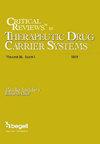Dendrimers for Therapeutic Delivery: Compositions, Characterizations, and Current Status.
IF 3
4区 医学
Q2 PHARMACOLOGY & PHARMACY
Critical Reviews in Therapeutic Drug Carrier Systems
Pub Date : 2019-01-01
DOI:10.1615/CRITREVTHERDRUGCARRIERSYST.2018025749
引用次数: 7
Abstract
Dendrimers, commonly referred to as arborols, offer tremendous opportunities for drug delivery, diagnostics, and treatment applications. This may be attributed to the characteristic features of their three architectural components: core, branches, and terminal groups. These components provide vast flexibility to designers. They act as highly moldable platforms that can be modified to suit the needs of application designers. Effectively, the type, length, and molecular weight of the core, branches and terminal groups may be customized to achieve desired characteristics and satisfy the demands of numerous applications. These perfectly designed multifunctional structures are reviewed in the current paper, focusing on their complex archetypical design for interphase applications; novel drug delivery applications, especially oral, ocular, pulmonary, transdermal; targeted, and controlled-release; and diagnosis and treatment of diseases like cancer, diabetes, and autoimmune disorders.用于治疗递送的树状大分子:组成、特征和现状。
树状大分子,通常被称为树酚,为药物输送、诊断和治疗应用提供了巨大的机会。这可能归因于它们的三个体系结构组件的特征:核心、分支和终端组。这些组件为设计人员提供了极大的灵活性。它们充当高度可建模的平台,可以根据应用程序设计人员的需要进行修改。实际上,可以定制核心、分支和端基的类型、长度和分子量,以达到所需的特性,满足众多应用的需求。本文综述了这些完美设计的多功能结构,重点介绍了它们在间相应用中的复杂原型设计;新型给药应用,特别是口服、眼、肺、透皮;定向控释;以及癌症、糖尿病和自身免疫性疾病等疾病的诊断和治疗。
本文章由计算机程序翻译,如有差异,请以英文原文为准。
求助全文
约1分钟内获得全文
求助全文
来源期刊
CiteScore
5.50
自引率
18.50%
发文量
27
审稿时长
>12 weeks
期刊介绍:
Therapeutic uses of a variety of drug carrier systems have significant impact on the treatment and potential cure of many chronic diseases, including cancer, diabetes mellitus, psoriasis, parkinsons, Alzheimer, rheumatoid arthritis, HIV infection, infectious diseases, asthma, and drug addiction. Scientific efforts in these areas are multidisciplinary, involving the physical, biological, medical, pharmaceutical, biological materials, and engineering fields.
Articles concerning this field appear in a wide variety of journals. With the vast increase in the number of articles and the tendency to fragment science, it becomes increasingly difficult to keep abreast of the literature and to sort out and evaluate the importance and reliability of the data, especially when proprietary considerations are involved. Abstracts and noncritical articles often do not provide a sufficiently reliable basis for proper assessment of a given field without the additional perusal of the original literature. This journal bridges this gap by publishing authoritative, objective, comprehensive multidisciplinary critical review papers with emphasis on formulation and delivery systems. Both invited and contributed articles are subject to peer review.

 求助内容:
求助内容: 应助结果提醒方式:
应助结果提醒方式:


